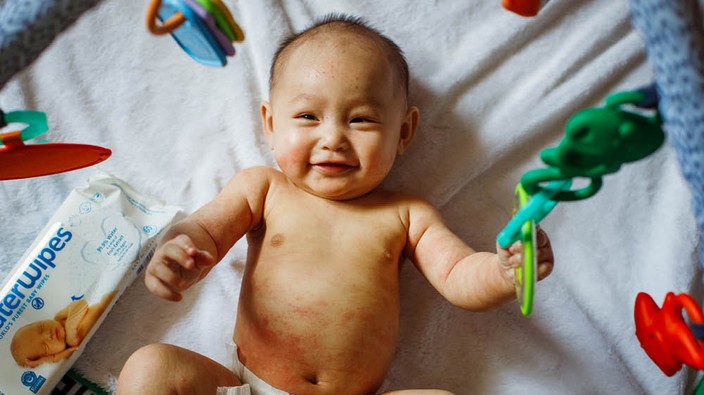how wipes mostly made of water are first step to protecting baby skin
waterwipes are so pure and effective that they are the preferred wipes in many neonatal intensive care units (nicus) around the world.

soft, delicate, and smooth: babies are thought of to have perfect skin. in reality, many little ones are prone to skin irritations. diaper rash to cradle cap, spots, bumps, and rashes are all common. as baby navigates new experiences, so does their skin. changes in the weather, new foods, or new products can all cause irritation. this is because baby skin is thinner and more permeable than adult skin – it has less protection against irritants such as allergens, bacteria, and viruses, and is also quicker to absorb water and other substances. this also means that baby skin is also less able to hold the moisture in and can become drier faster.
as the skin is the human body’s largest organ, it’s crucial to keep it healthy, yet it can be daunting for parents to respond to baby’s skin problems and to discern which ones need medical attention or can be handled at home.
to help differentiate, parents should become familiar with ‘transient’ baby rashes, which are essentially changes in the skin that have no medical significance and usually clear up without intervention. these can include conditions like heat rash and erythema toxicum, a common rash seen in full-term newborns. if rashes that are widespread across the body, and associated with itch, swelling, pain, fever, and difference in behaviour, it needs to be assessed by a medical practitioner. if in doubt, the safest thing to do is always to consult a healthcare expert such as your doctor or a pharmacist.
advertisement
common skin conditions in newborns and infants also include baby “acne” or erythema toxicum. these typically appear in the first few days after birth and tends to fades within a week. it’s theorized that the red, blotchy rash is triggered by hormones passed from mother to child through the placenta and breast milk, which aggravate sebaceous glands and lead to little, raised spots. these pimples usually appear on the cheeks, nose, and forehead, but they can also appear on the neck, back, or chest.
cradle cap—marked by thick, crusty, oily, or scaly patches or patches of yellow, greasy crusts—usually develops in the first few months after birth and typically clears up on its own within a few weeks. while it usually affects the scalp, it can also appear on the face, armpits, and groin.
then, there’s diaper rash, possibly the most common skin condition in babies worldwide. it’s characterized by pink or red patches on their bottom, which may feel hot to the touch, and skin that appears irritated and inflamed. spots, pimples, scaling, or blisters may also develop. severe diaper rash can cause discomfort and distress.
“it doesn’t matter if you use cloth diapers or disposable diapers, or how expensive your diapers are; diaper rash really comes down to how frequently you change the diapers,” says jill sommerville, director of medical at waterwipes. “leaving wet diapers on for a long time or a diaper that has poo in it can have a negative effect on the skin. because it’s sealed tightly, a diaper becomes like an incubator, and urine on the skin can begin to damage it. if you don’t change a diaper quickly enough or if you wipe the bottom then put a diaper on straight away when the bottom hasn’t had a chance to dry, it can be a bit nasty for a baby or sore for them.”
advertisement
especially effective at cleansing baby’s skin during diaper changes, waterwipes were born out of one family’s experience with bad diaper rash. after a fruitless search for a baby wipe that didn’t contain chemicals or ingredients that would’ve been too harsh for their baby’s sensitive skin, they decided to create their own.
made of 99.9 per cent water and a drop of fruit extract, waterwipes are one of the purest baby wipes. waterwipes are made with a unique purifying technology where water passes through a seven-step purification process that uses a series of filters to remove physical and chemical impurities, softening and purifying the water. this process makes the water in the wipes significantly purer than cooled boiled water. they’re effective at cleaning the skin without the need for several additional cleansing ingredients.
“the main difference between waterwipes and other wipe products is the number of ingredients,” says emer gilligan, waterwipes’ regulatory manager. “they contain only two ingredients compared to other products that can contain on average 12 or more ingredients. waterwipes are suitable for use on eczema-prone skin and allergy prone skin and on babies suffering from diaper rash.”
advertisement
waterwipes are so pure and effective that they are the preferred wipes in many neonatal intensive care units (nicus) around the world.
“waterwipes can be used for cleaning baby during diaper changes but also for cleaning hands, face and other body parts of all family members,” gilligan says. “they are suitable for sensitive skin and the delicate skin of newborn and premature babies.”
among the esteemed organizations that approve the use of waterwipes, including the french association for the prevention of allergies, the eczema association of australasia, and the skin health alliance.
for more information, see www.waterwipes.com.
this story was created by content works, postmedia’s commercial content division, on behalf of waterwipes
 4 minute read
4 minute read






